Wisdom Masters Press
An Academic Study of Climate Disinformation
To begin, I recognize that in today's world
there are many people who care more
for agendas and ideologies than realities, and those who belittle, ignore
or refuse to believe any truth that contradicts convictions they have chosen
or have been impelled or coerced to believe. So, I will open with a cautionary note by remembering the wise observations of
three brilliant minds.
“There are truths which are not for all men.” —Voltaire (A.D. 1694-1778)
“In a time of universal deceit, telling the truth is a revolutionary act.” —George Orwell
“Nothing in life is to be feared, it is only to be understood. Now is the time to understand more,
so that we may fear less.” —Madame Marie Curie, physicist and twice winner of the Nobel Prize
 Climate Disinformation - The Persistent Scourge, by Jenna Wolfe, Ph.D.:
Disinformation is a persistent scourge in efforts to disseminate
accurate information with respect to climate issues. Research indicates
that a significant portion of the American public has been gravely
misinformed by inaccurate narratives fueled by disinformation campaigns
orchestrated by certain vested interests.
Climate Disinformation - The Persistent Scourge, by Jenna Wolfe, Ph.D.:
Disinformation is a persistent scourge in efforts to disseminate
accurate information with respect to climate issues. Research indicates
that a significant portion of the American public has been gravely
misinformed by inaccurate narratives fueled by disinformation campaigns
orchestrated by certain vested interests.
To combat climate change disinformation, the
University of Geneva in Switzerland has taken a novel approach to
address the problem
by developing and testing psychological interventions intended to
assist people in identifying and fending off disinformation. A team led
by
Dr. Spampatti conducted extensive research involving nearly 7,000
participants, and each finding of the study underscores the persuasive
nature of
disinformation and the urgent need to counteract it. According to
Spampatti, certain corporate interests, lobbying groups and political
organizations have been spreading disinformation for more than 30 years.
• The study found that these disinformation messages have created, "An unfounded acceptance of inaccurate climate reporting by the
corporate
media and in political speeches, and a vast underestimation of the
socio-financial
burden of climate policies based on falsified information." Spampatti
and his colleagues developed a theoretical framework based on the
psychology of climate change disinformation. This framework considers
various factors, including the source, content, recipients, and
psychological aspects influencing the processing of information. ‘‘As
individuals, we do not process scientific messages as neutral receivers
of information, but by weighing them up against our prior beliefs,
emotional ties and socio-cultural and ideological backgrounds.
Depending on the configuration of these psychological factors, false
information can be amplified and become resistant to correction,'' explains Spampatti.
Based on their findings, the researchers
developed psychological intervention strategies to prevent climate
disinformation from influencing people's climate-related beliefs and
actions. They tested these strategies on 6,816 participants. Each
strategy focused on a specific theme:
verified scientific data, trust in accurate climate data, transparent
communication, and positive emotions towards factual climate
information.
• Yet the science of countering disinformation is still young. "Our intervention strategies didn’t work as hoped," said Spampatti, lead author of the study and a
neuroscience researcher. According to the study, climate change disinformation
persuades people “extremely effectively, far more than factual scientific information does.” The disinformation the participants were
exposed to during the study—meant to simulate the "fake news" people encounter in the media and on social media platforms—had an enormous impact, effectively overwhelming the intervention strategies and accurate climate information.
"All
sorts of strategies that would seem to be potent turn out not to
persuade people—or they do, but the effect is ephemeral, with people
reverting to their original false beliefs in as little as a week." Part of the problem was the "genuine appeal" of disinformation. A
primary finding of the study, published in Nature Human Behavior, is
that climate change disinformation is more persuasive than scientific
facts.
The study found, quote: “There is an alarming persuasiveness within climate disinformation. We
found that the protective effect of our strategies is small and
disappears following additional exposures to disinformation, especially
via the media,” said Spampatti. “Once these beliefs have taken root, it’s harder to disabuse people of them. Climate
disinformation used in this study had a negative influence on people's
understanding of climate change realities and sustainable behavior.
Research in this field is still in its infancy. We are going to
continue our work and look for more effective forms of intervention.”
Examples of Climate Change Disinformation
The study found four primary areas of climate disinformation that have been, quote: "Very
effectively utilized by vested interests, especially when propagated
through the mainstream media and on social media platforms."
1. Hurricane frequency and intensity
2. Wildfire frequency and amount of land area burned
3. Historically unprecedented floods and droughts
4. Deaths resulting from climate change influenced events
Here is a detailed examination of those four (4) specific areas of climate change disinformation, along with the actual facts.
NOTE: Lest anyone misinterpret it, the purpose of the following is not
to suggest that climate change has not been occurring, but rather to
provide accurate data from top research centers that can assist in
understanding climate issues which are frequently misrepresented by the
corporate media, social media platforms, and some politicians.
• Also please note that, although the majority
of climate disinformation is intentionally created and disseminated to
support a very specific agenda, some is the result of scientists engaging in
what's called "pathological science." Pathological science is a psychological process in which a scientist—initially conforming to the scientific method—unconsciously veers from a rigorous methodology and begins an intractable process of what's called "wishful data interpretation,"
generally resulting from the observer-expectancy effect, cognitive
bias, and/or an ideological belief system. Pathological science
presents an often convincing but easily falsifiable claim, as is
apparent when the claim is compared to the true and factual data, as follows:
•1) Disinformation: "Climate change is causing more frequent and increasingly intense hurricanes."
This is false. FACTS:
The comprehensive record of all hurricanes that have made landfall
since 1851—including those in 2023—shows no upward trend in the number
of major hurricanes over the last 172 years. Moreover, there has been a
50 percent reduction
in the number of major hurricanes (Category 3 or greater) making
landfall in the U.S. over the last 90 years, since the 1930s.
Sources: National Oceanic and
Atmospheric Administration (NOAA); Princeton Geophysical Fluid Dynamics
Laboratory; U.S. Geological Survey; National Hurricane Center; National
Weather Service; High Meadows Environmental Institute, Princeton
University; et alia.
• This chart is from the Princeton Geophysical Fluid Dynamics
Laboratory covering a period of 1980 through July 31, 2023.
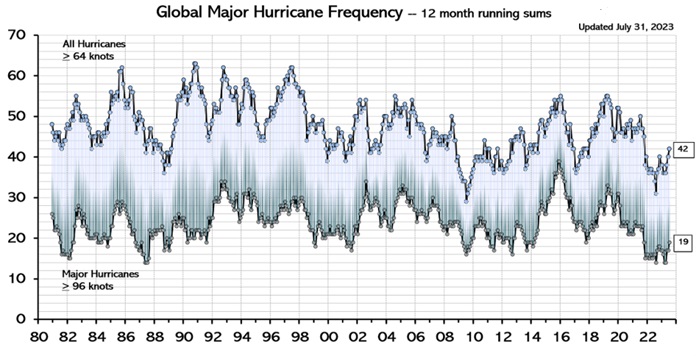
•2) Disinformation: "Climate change is causing more frequent, larger and more intense wildfires."
Also false. FACTS:
The world's land area is 57,510,000 square miles (148,940,000 sq km),
which is 29.2% of the Earth's surface (70.8% is water and ice). Around
the turn of the century in 1900, an estimated 4.5% of the land area of
the world burned in wildfires every year, or an average of about
2,587,950 square miles annually. By the year 2000, NOAA and the NCDC
reported that this had declined
to 3.2%, or 1,840,320 square miles, a reduction of 29 percent. Then,
over the last two decades, NOAA satellites show an even further
decline. In 2021, about 2.7% burned, and in 2022 just 2.4% burned,
about 1,380,240 square miles, a REDUCTION
of 47 percent in land area burned, some 1,207,710 fewer square miles
than in the early 1900s (an area the size of India), and 460,080 fewer
square miles than in 2000.
The current data is showing the total amount of land area burned in 2023 is estimated to have been 2.6% of the world's land area, approximately 1,543,750 square miles, a REDUCTION of 41 percent in land area burned over the last 120 years, some 1,044,200 fewer square miles than in the 1900s. Sources:
National Oceanic and Atmospheric Administration (NOAA) Geostationary
Satellite Data (2022), Washington, DC; the National Climatic Data Center (NCDC), Asheville, NC;
and the Princeton Environmental Institute, Princeton, NJ.
FACTS: In
the United States, the peak in the number of acres burned actually
occurred in 1930 with over 52,000,000 acres burned, compared to
7,577,000 in 2022, a DECREASE of 85%, and 2,634,000 acres burned in
2023, a DECREASE of 95% over the last 93 years. And the peak in the
number of wildfires actually occurred in 1981 with about 244,890,
compared to 69,988 in 2022, a DECREASE of 71%, and 55,570 wildfires in
2023, a DECREASE of 77% over the last four decades. Source:
The National Interagency Fire Center (NIFC), the nation's center for
wildland fires, providing statistics that encompass lands managed by
all federal, state, local, tribal, and private agencies.
This chart is from the National Interagency Fire Center covering a period from 1926 through 2020. Since the late 1970s and early 1980s, the actual number of wildfires in the United States has dropped by over 75%.
The arrows pointing down on the left side of the chart indicate the
true record years for heat and drought in the U.S., which occurred in
1930 through 1941, the era of the infamous "Dust Bowl," which began 93
years ago and ended 82 years ago. NOTE: Please beware of the disinformation where this chart has been censored by showing the first date at the
lowest point in the number of fires, the very wet year of 1983, to make it appear that wildfires are
becoming more frequent and burning more acreage, intentionally omitting
the previous 58 years, since that would be devastating to their false
narrative.
1930 1941
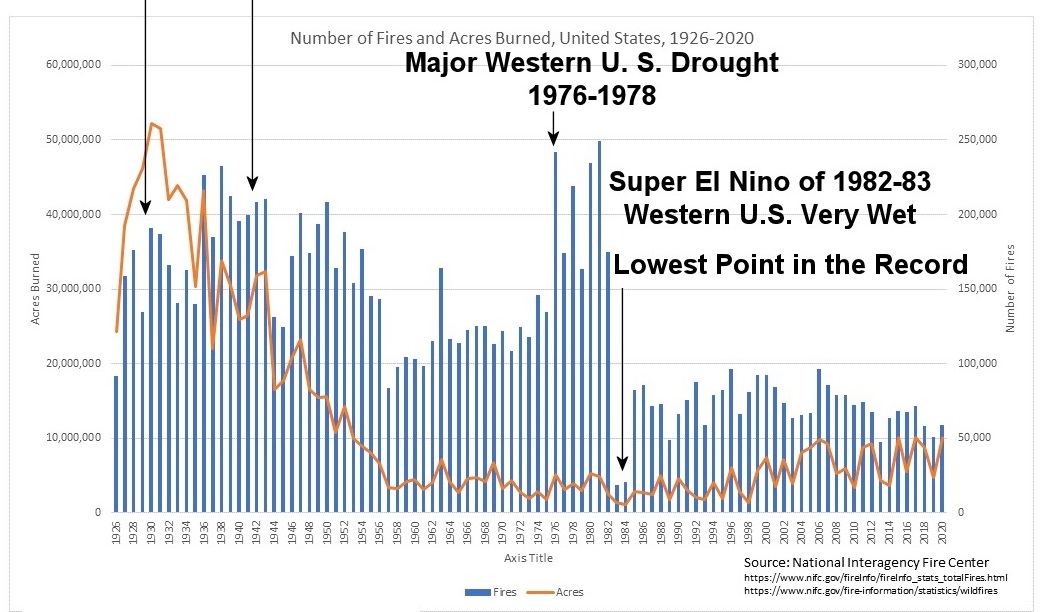
•
3) Disinformation: "Climate change is causing historically unprecedented floods and droughts."
Also false. FACTS: A very clear graphic representation of the actual data is presented in this new chart from
NOAA's National Centers for Environmental Information titled "U.S. Percentage Areas Very Wet/Very Dry." The chart covers a period from January 1895 to August 2023—128 years—and is described as follows:
"Contiguous United States percentage areas are based on the U.S.
Climate Divisional Dataset. Climate divisions with a standardized
anomaly in the top ten percent (> 90th percentile) of their
historical distribution are considered 'very wet' and those in the
bottom ten percent (< 10th percentile) are classified as 'very dry'."
In other words, the chart clearly shows what
percentage of the U.S. was either unusually wet or unusually dry
through the entire time period of 128 years. You can see the results
for yourself, of course, but obviously
over the last several years there have been some wet and dry months,
yet despite the media's claims, nothing that exceeds many previous very wet or very dry months over the last 128 years. If you look closely, you can see that there have been dozens
of months going back to January 1895 that were either much wetter or
much dryer than in recent years.
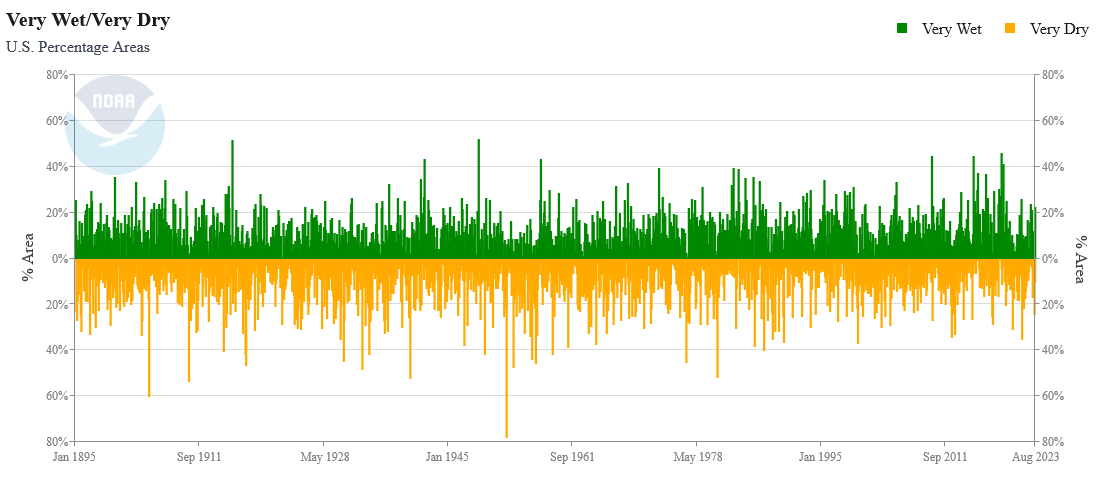
For
a much longer term view, the chart below depicts a reconstruction from
tree rings and other reliable proxies of the wet and dry pattern in
North America and Europe over the 1012
year period from the year 1000 to 2012, with direct observational data
from 1901 to 2018 displayed on the right. Dryness is denoted by negative values (below the 0 line), wetness by positive values (above the 0 line). The blue line denotes a running average of wet/dry periods. Sources:
NOAA's National Center for Environmental Information; The
National Science Foundation's Center for Atmospheric Research, Palmer
Drought Severity Index (scPDSI); Communications Earth & Environment, 2/61 (2021), et alia.
Again, you can see for yourself, but please
note that during the 118 year period from the
year 1900 through 2018 there are no exceptionally or unprecedentedly wet or dry periods, and the running average (blue line) is actually in a very stable pattern with little negative (dry) or positive (wet) fluctuation as compared to the preceding 900 years from 1000 to 1900.
• In summation, the information on the two charts makes it abundantly clear any claim that "Climate change is causing historically unprecedented floods and droughts" is baseless and represents a pure fabrication.
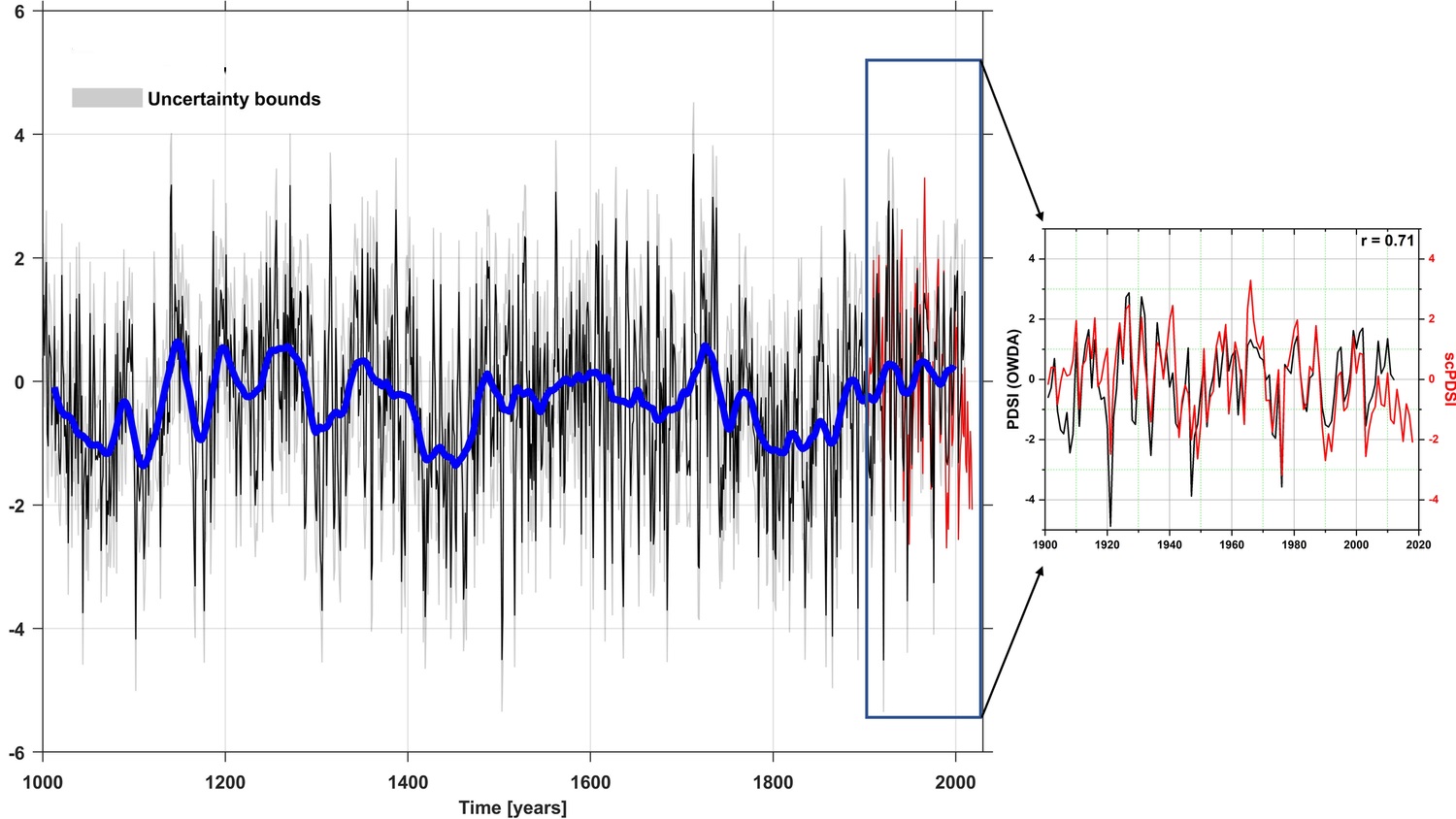
4) Disinformation: "Climate change is generating record death tolls worldwide."
Also absolutely false. FACTS:
The truth reveals one of the greatest accomplishments of modern
civilization. Comprehensive analysis from the OFDA/CRED International
Disaster Center, The Global Change Data Lab, and the Institute for
Health Metrics and Evaluation shows a dramatic decrease
in the global annual death rate from all climate related events
(hurricanes, tornadoes, floods, droughts, landslides, extreme
temperatures) over the last century. Deaths have fallen from a high of
0.61 per 100,000 people in the 1920s, when reliable, accurate records begin, to 0.04 per
100,000 people in the 2010s, a decrease of 93.4%.
The data for 2020 indicates a further drop to an estimated 0.031 per
100,000 people, an average decrease in climate related deaths of 22.5%
from the decade of 2010 to 2019.
And the International Disaster Center, Global
Change Data Lab, and Institute for Health Metrics released this report
in July 2023: "For 2022, the data is now complete and shows a
98.7% REDUCTION in the number of deaths from climate-related events
over the period of the last 100 years. Additionally, 2022 shows a
reduction of 58.8% in climate-related deaths from the year
2020."
Sources:
The OFDA/CRED International Disaster Database (Centre for Research on
the Epidemiology of Disasters), UniversitÚ Catholique de Louvain,
Brussels, Belgium; The Global Change Data Lab, a co-operative
organization of University College London, University of Oxford, and
the University of Bristol, England, UK; and The Institute for
Health Metrics and Evaluation, Population Health Center, University of
Washington, Seattle, WA.
• The chart below is from 'Our World in Data'.
The decadal record for the 103 year period from 1920 through 2023 is
based on EM-DAT data-sets, CRED data-sets, and incorporates data
from the OFDA International Disaster Database. For example, the bar for
1920 represents the numbers for 1920 to 1929, and so on. Note: Data for the years 1900 through 1919 is unavailable, incomplete, and/or unreliable.
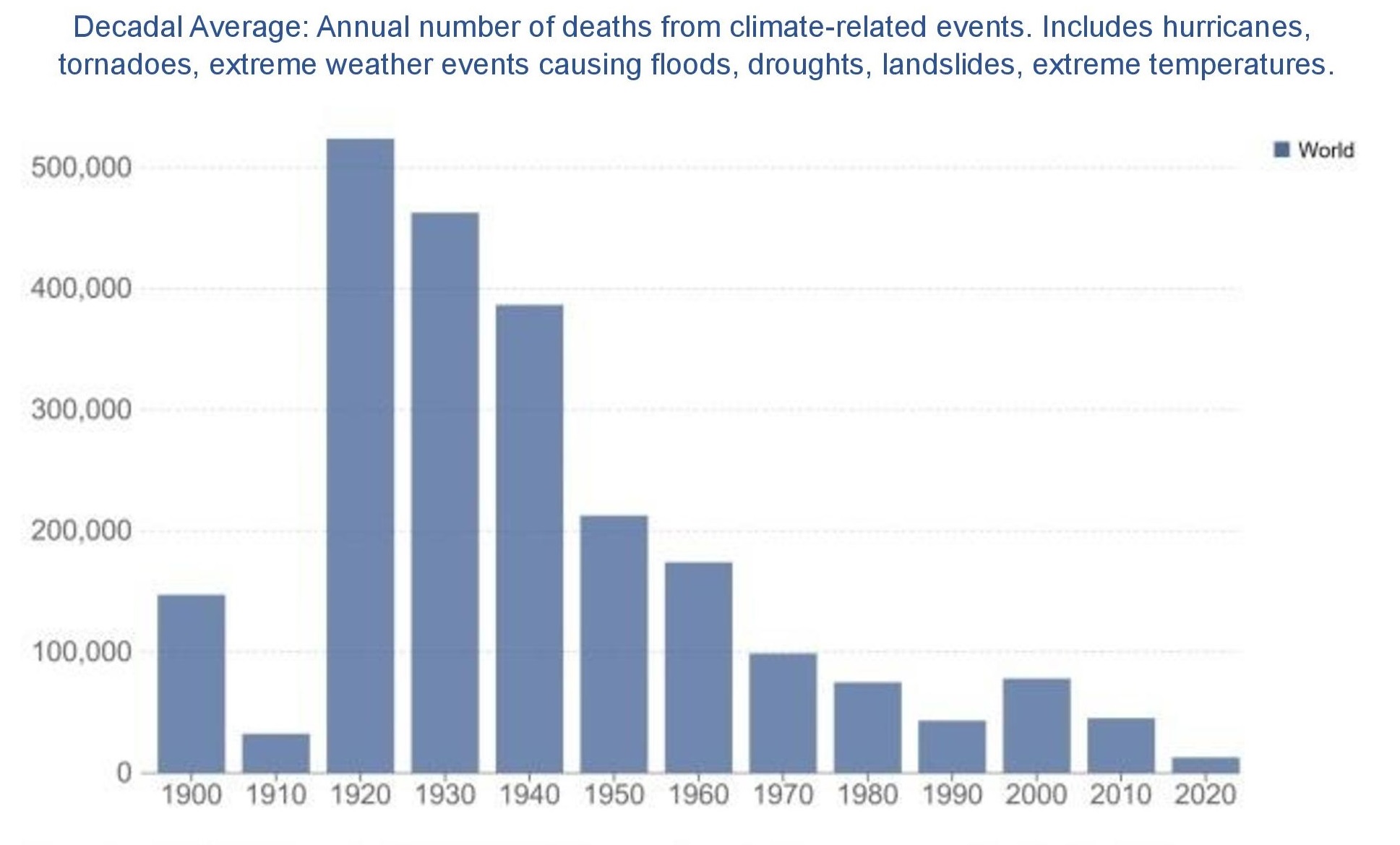
POINT: The study found this example of climate disinformation—"Climate change is generating record death tolls worldwide," in some cases baselessly claiming 15 million deaths each year—is by far
the most heinous and destructive in its impact. A profound danger of
this extreme form of climate disinformation is the creation of stress,
grief, and despair, which has become a growing mental health problem.
An innovative study published in 'The Lancet' found that over half of
respondents between the ages of 16 and 25 reported feeling very or
extremely worried about the climate. This new form of mental stress has been
dubbed “climate anxiety” or “climate-catastrophe anxiety.” Defined as a
“heightened emotional, mental or somatic distress in response to
perceived changes in the climate system,” climate anxiety can create a
sense of hopelessness, grief, anger, guilt, and existential dread.
Distress about climate change is especially dangerous in young people
who have been indoctrinated by climate disinformation to believe that
they have no future, and that humanity is doomed. This erasing of the
line between fact and fantasy is extremely dangerous.
The study further noted: "The
indoctrination required to create climate-catastrophe anxiety succeeds
when disinformation causes people to disbelieve or ignore accurate
climate facts and data and thereby lose contact with the reality around
them, and without these contacts, individuals lose the capacity of both
experience and thought. The ideal subject for climate-catastrophe
anxiety is not just the na´ve young person or the significantly
gullible, but people for whom the distinction between fact and
fiction—i.e., the reality of experience—and the distinction between
true and
false—i.e., the standards of thought—no longer exist."
The
phenomena of disinformation with respect to climate science dates back
decades, and its role and influence on policy has been researched
extensively. Politically-motivated organizations, for example, have
been singled out for their role in funding politicians, think tanks, and media
outlets that specialize in casting doubt on accurate climate data and
spreading disinformation, behavior that has “substantially contributed to influencing global climate policy for decades.”
The purpose of this web of disinformation has been to confuse the
public and decision-makers in order to attack free-market ideologies.
The means by which climate disinformation is disseminated is worth considering: “Well-credentialed pundits serve as spokespersons on media forums outside any peer-review or fact-checking process.”
Thus, it appears to policy elites, journalists, and of course the
general public that there is a legitimate “set of climate
data” which is in reality fabricated disinformation, and that it should receive serious attention. Climate
disinformation advocates sow confusion in a public that is often
unaware that the true data elements of climate science have actual
vetting, good-faith researchers, corroboration, and peer-review.
Additionally, “It has proven difficult to
identify all the funding sources that support the Climate Disinformation Industry (CDI). Many
of the organizations that disseminate climate
disinformation are nonprofit groups or foreign entities which are not required to disclose
their donors, and organizations whose funding is channeled through
offshore accounts which cannot be properly traced. In addition to those
directly associated with far-left
interests, key funding of dissemination of climate disinformation has
often been part of a broader constellation promoting baseless
government policies and regulations in general.”
Whether during a presidential election year or not, there is now grave
concern about politically-motivated groups or individuals spreading
false information in order to influence or change public opinion—as
well as growing concern over financially-motivated schemes to produce
"news" articles with fear-mongering disinformation to attract clicks.
With respect to current political debates, many of the hegemonic
political projects, while admittedly amorphous, are the efforts of
political forces to promote far-left political narratives, leaders, and
policies. Critics argue that these forces “Pose
a serious threat in large part due to their aim to contribute to the
undermining of the institutions of democracy and a free society.”
•
Psychological Elements of Disinformation
The question is often asked: Why is climate change disinformation regarding hurricanes, wildfires, floods, droughts,
and alleged death tolls so appealing and
persuasive? Here's a deeper look from research and findings in the field of neuroscience.
Disinformation, climate or otherwise, acts as a kind of “surrogate life.” "You
absorb it so seamlessly that you might think you knew something—like
hurricanes supposedly increasing in number, say—before having been
exposed to disinformation from the primary CDI purveyors like IPCC and EDF, or secondary purveyors like CNN, MSNBC, Grist or wherever. And you'll also retain that false
information even if you didn’t mean to."
This certainly seems like a liability:
Philosophers have long concerned themselves with what they call “the
paradox of propaganda”—why would we find fabricated stories emotionally
appealing at all? The answer is that most of our mind does not realize
that fiction is fiction, so we react to it as though it were real, and
the more it elicits an emotional reaction to a sense of danger or
threat the more real it seems.
Those who fabricate and disseminate climate
disinformation utilize this powerful psychological aspect of fear as a
very effective tool in creating a false sense of reality for the
consumers of their propaganda. A Berkeley psychology professor described disinformation as, quote, "An
extraordinary propaganda campaign directed at the young, the
uninformed, the mentally unstable, and the na´ve, utilizing powerful psychological techniques of
manipulation."
•"Our brains cannot help but believe."
• In
the field of psychology, this is known as scotomisation or motivated perception, which
means the way
in which the brain interprets the truth when it expects to see a
certain thing, the psychological tendency in people to see what they
want to see and not see what they don't want to see, often described as
"the mind sees what it wants to see." There’s
a great amount of experimental evidence for this. Children, for
example, sometimes believe that puppets are alive. Even
animals sometimes react to pictures the same way they react to real
things. The industrialized world is so full of representations and narratives, like in
media and in ads, that we forget that it’s just ink, or pixels on a computer screen.
"Every
time our
ancestors saw something that looked like a human face, it was one. When
they saw what looked like a water source in the distance, a stream or
pond, it actually was one. If they saw impala or wildebeests on the
horizon, they were real. As a result, we did not evolve to distinguish
reality from falsity. The same perceptual machinery interprets both.
These parts of our minds, even in the prefrontal cortex, do not know
that what we’re seeing, or reading, isn’t real." And these perceptual areas of our brains are very
closely connected to our emotions. That’s why emotions don’t just
motivate us to act in certain ways but force us to interpret the world
differently.
•
Disinformation - Intent & Sources
The consistent question from study participants regarding the
disinformation and fabrications they had heard from politicians and the
media was: "What's behind all the disinformation? What the heck is going on?"
This is a very good question. Fortunately, there are some clear
answers. It is important to understand that the people who promote
disinformation generally fall into one of four (4) categories.
•1)
In the first category are the disinformation architects and
disseminators, who operate from a very specific agenda. Most of the
climate propaganda trumpeted by politicians, the media and many others, originates from the United
Nations' "Intergovernmental Panel on Climate Change." In media articles regarding climate change, the United
Nations’ Intergovernmental Panel on Climate Change (IPCC) is often referred to as "the gold
standard of climate science." In reality, the IPCC is a highly
politicized organization that doesn’t actually carry out any original
climate research. Instead, it simply issues assessments based upon
supposedly independent surveys of published research. However, the majority of
its most widely-publicized conclusions summarized from its reports are
neither based upon independent research nor have they been properly
vetted through accepted peer-review processes. So what is the basis of
their reports? What is their intent and purpose?
• In a rare moment of honesty, Ottmar Edenhofer,
an IPCC official and Co-Chair of IPCC Working Group III, said this,
quote: “One
has to free oneself from the illusion that international climate policy
is environmental policy. It has almost nothing to do with environmental
policy. Instead, climate change policy is about how we redistribute de
facto the world’s wealth.” This statement represents a very clear expression of their true intent.
At another event he said this: “First
of all, developed countries have basically expropriated the wealth of
the world community. But one must say clearly that we must redistribute
de facto the world's wealth by climate policy. Obviously, those who
produce the world's wealth will not be enthusiastic about this. But one
has to free
oneself from the illusion that international climate policy is
environmental policy.”
Edenhofer's comments are consistent with
others who have admitted the true purpose of the IPCC agenda. Last
year, Christiana Figueres, executive secretary of the UN's Framework
Convention on Climate Change, made a similar statement: "This
is the first time in the history of mankind that we are setting
ourselves the task of intentionally, within a defined period of time,
changing the economic development model that has been reigning for at
least 150 years, to replace free-market capitalism with a global,
socialist economic state. This is probably the most difficult task we
have ever given ourselves, which is to intentionally transform the
entire economic world model."
• In
their persistent effort to reach this goal, the United Nations has a
long history of claiming catastrophe is right around the corner. The
first UN environmental director claimed half-a-century ago that we had just "10 years left" before a "climate catastrophe." And the IPCC director in 2007 insisted that we had just five years before a "climate collapse," and made the astonishing claim that "by 2015, rising seas will displace 187 million people, potentially drowning entire cities."
• Further proof of the IPCC's true agenda can be
found in the fact that, since 1988, the IPCC has issued six (6)
Assessment Reports, each of which is accompanied by separate "special"
reports. A systematic analysis shows that the reports contained thirty-two (32) very
specific predictions of climate or environmental conditions that would
manifest by the year 2022. Interestingly, not one of those predictions has actually occurred.
As the famous American physicist Richard Feynman once explained:
"It does not matter who you are, or how smart you are, or what title you have,
or how many of you there are, and certainly not how many papers your side
has published, if your predictions are wrong then your hypothesis is wrong. Period."
•
A representative example is the 2022 IPCC report which used selective
data, doctored graphs, and baseless claims in the text. The many
irregularities provoked Dr. Frederick Seitz, a world-famous physicist
and former president of the U.S. National Academy of Sciences, the
American Physical Society, and Rockefeller University, to write in the
Wall Street Journal: “I have never witnessed a more disturbing corruption of the peer-review process than events that led to this IPCC report.”
Several hundred climate scientists lodged formal protests regarding unscientific IPCC practices, including complaints that
their work suffered "significant shortcomings" including "invalid modeling tools," "grave modeling errors," "implausible and
inadequately supported assumptions," and "predictions devoid of any scientific evidence." A MIT climatologist wrote:
"Viewed from the largest perspective, the global warming rubric has provided an ideal platform
to accomplish exactly what UN leaders have stated as their goal, to enable the UN to advance
large transformational visions of socialism, wealth redistribution, and ultimately, global governance."
•2) In the second category are what in the academic study of propaganda are referred to as “disinformation agents.”
These people are commonly found on social media platforms such as X
(formerly Twitter), Instagram, YouTube and TikTok; and on websites such
as Vox, The Guardian, and so on. The utilization of these forums to
spread disinformation is understandable. Activism on social media
provides
people with an emotional outlet and gives them a sense that they are
doing something.
Social media platforms are designed to
maximize engagement. Their algorithms are constantly tweaked to make sure that
users spend a lot of time on them, and the best ways to drive
engagement are to either show people what they will likely agree with
or show them content that will frighten or anger them. As a result, the content you will most
frequently encounter on social media will either mirror the views you
have already adopted or upset you, or both. In other words, engagement
on social media typically does not generate any new knowledge, it only
reinforces fabrications. When it comes to a conflict as convoluted and
as emotionally charged as climate facts vs. climate fear-mongering myths, those are
terrible outcomes.
• Climate disinformation has no real evidence,
so disinformation agents find or make up people to support their
assertions. These impersonations can take multiple forms. For example,
disinformation agents sometimes use anecdotes as evidence, especially
sympathetic stories from vulnerable groups such as women, children, or minorities.
Similarly, they may disseminate “concerned citizens” perspectives,
laypersons who present their social identity as providing the authority
to speak on a climate issue: “As a mother …,” “As a veteran …,” or “As a police officer
…” Also utilized are “convert communicators,” people who allegedly
changed from the “wrong” position to the “right” one, and this can be
especially persuasive. These people often don’t actually exist, or may
be coerced or paid.
• In addition to ordinary people, “fake experts” are frequently used, and these people basically fall into five (5) groups:
•• Faux expert. This is someone used for their title, like a Ph.D. or M.D., but who does not have any actual relevant expertise in
the field of climate science. A nutritionist, veterinarian, or cardiologist are examples.
•• Pseudo-expert. This is someone who claims relevant expertise, but has no training or experience in the field. These people
can be identified by this trait—they never present any authentic evidence for their claims—either
their so-called 'proof' is
predicated on a series of sub-proofs leading to an infinite regression, or it tracks back to
arbitrary axiomatic statements, or
it's ultimately circular, i.e. “we know hurricanes have become more frequent because hurricanes have become more frequent.”
•• 'Junk' expert. A junk expert is a sellout, and unfortunately this has become very common. They may have expertise, but now
say whatever is profitable, or whatever protects their job and
career. An
editor at 'New Scientist' magazine explained the
situation nicely: “Political
forces are working on many levels to deceive the public into thinking
there is unanimity on
climate issues by stifling and de-funding any
scientist who attempts to publish contrasting facts, no matter how
well-established. We've heard this from dozens of highly respected
researchers, all saying the same thing. Einstein
could not have gotten
funding in this kind of oppressive political environment.”
Richard Lindzen, a professor of Atmospheric Science at the
Massachusetts Institute of Technology (MIT), put the situation
clearly: “Scientists
who dissent from climate alarmism have seen their funds disappear,
their work derided, and
themselves falsely labeled as industry stooges
or climate deniers.” You'll find these people independently making false
claims—for example, “wildfires are burning more area than ever before”—or speaking for institutes or media outlets that
regularly promote false claims.
•• Echo expert. This is a person who uses disinformation sources which cite to each other in an attempt to provide evidence
for their claims. You'll see this as their opening, “As reported in ...” CNN and MSNBC routinely cite stories from The New
York Times or The Washington Post, and visa versa, creating what is
called "an echo chamber of disinformation."
•• Stolen expert. This is someone who exists, but who was never actually contacted and their research is misinterpreted
or misrepresented.
•3)
The third category consists of the media personalities and politicians who
echo the IPCC and other propaganda and are motivated by essentially the same
agenda, a transition of the U.S. economy from its current form of
limited capitalism to a socialist model.
For example, during an interview with The Washington Post, Saikat
Chakrabarti, former chief of staff of New York Rep. Alexandria
Ocasio-Cortez (D), revealed that her so-called “Green New Deal” that
has dominated the Democrat's agenda is in truth a plan to completely
transform America’s economic system. “The interesting thing about the Green New Deal,” Chakrabarti said, “is
it wasn’t originally a climate thing at all. Do you guys think of it as
a climate thing? Because we really think of it as a
how-do-you-change-the-entire economy to socialism thing.” He
explained that the Green New Deal is designed to transition the U.S.
from an economic system based on capitalism to a collectivist system
based on socialism, utilizing climate change as, quote, "a kind of Trojan horse." Chakrabarti characterized 'The Green New Deal' as "a socialist wishlist disguised as climate policy."
•4)
The fourth category consists of people who uncritically believe the baseless climate
disinformation and fabrications promoted by the media and some
politicians. This group includes young people, the gullible, the
ideologically-biased, and those who still trust the media (according to
Susquehanna Research, that's about 22% of American voters). It is often
difficult to distinguish between those who spread malicious propaganda
intentionally and those who are merely na´ve believers, and in any case, the distinction may not be necessary.
Political Propaganda - The Very Strange Case of John Kerry
While keeping the real facts in mind, it is informative to examine a bit of the political propaganda surrounding climate change. Disinformation
regarding the climate doesn't come only from the media, of
course, many politicians eagerly join in. As a typical and very
representative example, let's take a look at the claims made by an
ostensibly knowledgeable person, the one Joe Biden picked to be his
“Special Presidential Envoy for Climate,” John F. Kerry, who has been making amazing claims
for decades, and here I must assure you that
this is entirely accurate and is not a parody.
•A brief sample of statements made by John Kerry, and please keep an eye on the dates:
• • In an Associated Press interview in 1989, Mr. Kerry said, "Entire nations will be wiped off the face of the Earth by the
year 2000 if the global warming trend is not reversed."
• • In a 2007 article in 'The Guardian', John Kerry wrote, "Time is running out to tackle global warming. We have no more
than 10 years left to save the world."
• • On 'CBS This Morning' in June 2008, Mr. Kerry declared, "By 2015, climate change will cause New York City to be
underwater."
(If you live in or often visit NYC, you may be forgiven if you find this totally absurd.)
• • Speaking at Miami Dade College in 2009, Mr. Kerry stated, "By 2015, about 60 percent of Miami-Dade County will be
submerged."
(And of course if you live in Miami, you might find this rather disingenuous.)
• • In 2009, Kerry ominously predicted that global
warming was such an imminent threat to humanity that, "The Arctic will be
ice-free by 2014."
(But according to NOAA, the Arctic ice sheet actually experienced record growth from 2013 to 2014.)
•• In 2018,
appearing with Greta Thunberg, Mr. Kerry asserted, "Climate change will wipe out all of humanity unless we
stop using fossil fuels over the next five years."
(So "all of humanity" was supposed to be wiped out by last year, 2023.)
• Here are a few more of the interesting predictions Kerry made over the decades. In 1962 - "Oil will be gone in 10 years." In 1975 - "Another Ice Age is coming in 10 years." (An Ice Age, really?) In 1984 - "Acid rain will have destroyed all crops in 10 years." In 1991 - "The ozone layer will be destroyed in 10 years."
In 2004 - "Both polar ice caps will be gone in 10 years." Not exactly an optimist, is he? Back in 2020, even NBC News reported that
"John Kerry's climate predictions have never been accurate."
• Interestingly,
after a number of speeches John Kerry made at the 'UN Climate Change
Conference' in Dubai, United Arab Emirates, in December of 2023, a
government watchdog group—'Protect the Public’s Trust'—filed an
ethics complaint against Mr. Kerry, charging him with spreading false
information about climate change. The complaint notes
that that on multiple instances John Kerry violated the 'Federal Scientific Integrity Policy'—which
requires officials to "communicate scientific information accurately
based on the best available evidence"—and requested a federal
investigation into Mr. Kerry, his statements, and his continuing in
the role of 'Special Presidential Envoy for Climate'.
The ethics complaint states: "John
Kerry’s recent claims that the continued existence of the planet is at
risk, and that global warming is causing 15 million annual deaths,
are hysterical pronouncements of the most dangerous type. These claims
have been made entirely without evidence and designed to frighten the
public to advance a political agenda. In short, it is precisely the
sort of disinformation the administration’s and State Department’s
scientific integrity policies were intended to prevent."
"Such
blatant misstatements of scientific information to the public are, by
their very nature, a threat to public trust and good governance. It is
made
far worse when such disinformation is used to publicly support sweeping
policy changes, which would have untold effects upon the economy and
lives of the American people writ large."
• So what can we surmise about Mr. Kerry? All of his claims, past and present, make one thing perfectly obvious—none
of his claims or "predictions" are based on any kind of valid scientific studies
or evidence, they are motivated by something else entirely. And it's worth noting that John
Kerry owns two large yachts, 12 cars (none of which are electric), a
private jet (titled to a holding company), and six homes. This
includes a $12 million waterfront estate on Martha's Vineyard, which he
purchased in March of 2017 and has never offered for sale, even though he's certainly aware
that in its location on a beach right by the ocean, the main floor of the mansion it is merely 3 feet, 4 inches above
sea level at mean high tide. Remember that Mr. Kerry claimed that New York City would be "underwater" by 2015—and NYC has an average elevation of 33 feet above sea level.
• UPDATE - JANUARY 14:
John Kerry announced that he will step down from his position as
Biden’s special climate envoy in late winter or early spring, as
reported by numerous media outlets on Saturday, January 13th. Kerry’s
departure from the position comes just weeks after he led the U.S.
negotiating team at the U.N. climate conference in Dubai. The news was
first reported by Axios, which went on to say that Kerry is stepping
down "to help with Biden’s reelection campaign."
Another source, a person on Kerry's climate
team who was granted anonymity, said that in exchange for Kerry's
resignation a deal had been made to
withdraw an ethics complaint lodged by 'Protect the Public’s Trust',
and to permanently suspend pending investigations by the 'House
Committee on Ethics' and the 'Office of Congressional Ethics'.







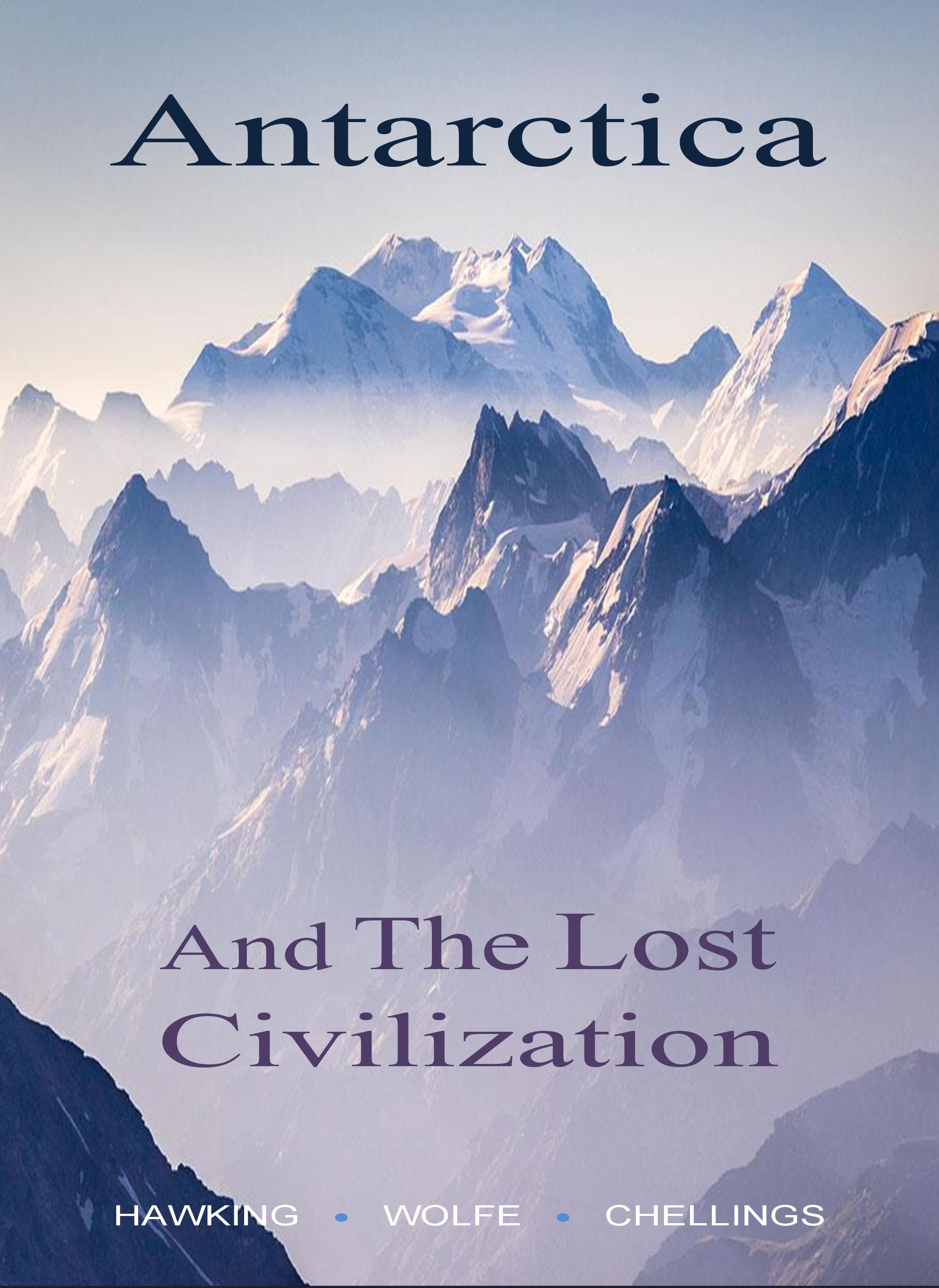
 Climate Disinformation - The Persistent Scourge, by Jenna Wolfe, Ph.D.:
Disinformation is a persistent scourge in efforts to disseminate
accurate information with respect to climate issues. Research indicates
that a significant portion of the American public has been gravely
misinformed by inaccurate narratives fueled by disinformation campaigns
orchestrated by certain vested interests.
Climate Disinformation - The Persistent Scourge, by Jenna Wolfe, Ph.D.:
Disinformation is a persistent scourge in efforts to disseminate
accurate information with respect to climate issues. Research indicates
that a significant portion of the American public has been gravely
misinformed by inaccurate narratives fueled by disinformation campaigns
orchestrated by certain vested interests.



